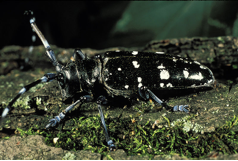Profile of wood-boring beetle’s midgut microbial community identifies candidate genes involved in processes including lignin degradation
The Science
Metagenomics allowed researchers to conduct a functional analysis of the midgut microbial community in the Asian longhorned beetle (Anoplophora glabripennis), an invasive insect that feeds on lignin in deciduous trees such as poplars and willows.
The Impact
This study is the first large-scale functional metagenomic analysis of the midgut microbial community of a beetle with known lignin-degrading capabilities. The candidate genes identified from by the functional profile could lead to novel enzymes that might either be useful for industrial biofuels applications or else be used to control this invasive insect.
Summary

The Asian longhorn beetle is an invasive pest that can break down lignin in host deciduous trees.
(Wikimedia Commons)
The Asian longhorned beetle is an invasive species first discovered in the United States in 1996. It attacks both healthy and stressed hardwood trees, including the bioenergy candidate feedstocks poplar and willow, and has no natural enemies in this environment. The microbial community in the beetle’s midgut is capable of breaking down the lignin, cellulose and hemicellulose in the trees to acquire needed nutrients, but little is known about the processes involved. To learn more about how microbial communities in the guts of such wood-boring insects break down these woody tissues, a team including DOE Joint Genome Institute researchers sequenced, assembled and analyzed the Asian longhorned beetle’s midgut metagenome.
In the study published September 4,2013 in Plos ONE, the team compared the metagenome assembly from the wood beetles to annotated assemblies in the DOE JGI’s IMG/M database. These datasets came from microbial communities associated with herbivores that feed to plant tissues, insects that feed on specific plant tissues, and insects that feed only on woody tissues. The findings revealed that the beetle’s midgut contained a community dominated by aerobes, which researchers expected, noting that large-scale lignin-degrading reactions require oxygen and have only been demonstrated in aerobic environments. They identified several genera of fungi and bacteria in the assembly; many of the microbes have been associated with break down of lignocellulose, hemicellulose and other similar compounds. The metagenome assembly also led to the identification of candidate genes for a variety of functions, including lignin degrading enzymes, cellulases, xylose utilization and fermentation as well as for nitrogen and nutrient acquisition.
“This study represents the first large scale functional metagenomic analysis of the midgut microbial community of a cerambycid beetle with documented lignin degrading capabilities,” the reserachers concluded. “The midgut community of A. glabripennis has the metabolic potential to produce enzymes to help this wood-boring insect overcome major nutritional challenges associated with feeding in woody tissue and we hypothesize that interactions between the beetle and its gut microbes drive this insect’s ability to colonize and thrive in a broad range of healthy host trees. This wood-degrading system should also have great potential for the development of novel lignocellulose degrading enzymes for applications by the biofuels industry.”
Contact
John E. Carlson
Pennsylvania State Univeristy
[email protected]
Funding
DOE Office of Science, Office of Biological and Environmental Research
US Department of Agriculture
Alphawood Foundation
Pennsylvania State University College of Agricultural Sciences
Publication
Scully ED et al. Metagenomic Profiling Reveals Lignocellulose Degrading System in a Microbial Community Associated with a Wood-Feeding Beetle. PLoS ONE. 2013 Sep 4; 8(9): e73827. doi:10.1371/journal.pone.0073827